|
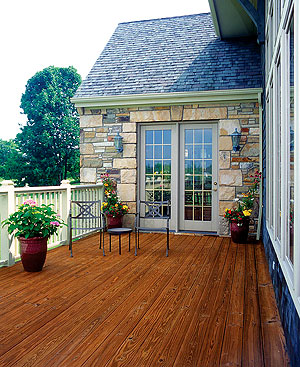
Wood Decks and
Wood Deck Cleaning
If your customer wants to get the gray out of a wood deck, be careful about pressure washing. Here's a look at cleaning products for wood decks and tips on the best methods for using them. You'll also find info on the care of composite decking.
by John Strieder
First, consider why wood decks turn gray in the first place. The ultraviolet rays in sunlight, with help from moisture and other natural elements, break down the surface of the wood over time, weathering its rich colors into a dull gray.
Removing the gray means one of two things: stripping away the loose, weathered residue mechanically or washing it away with some kind of cleaning solution.
The preferred way to scour off gray fibers is to blast them away with a pressure washer. But you have to know what you're doing, says Jake Clark, president of Armstrong-Clark Co. It can raise the grain, he says. "If you lean into the pressure washer too hard, it can take a smooth board and make it rough."
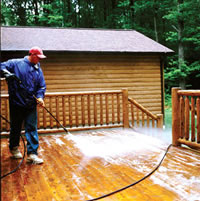 Leslie Juhn, Wolman Wood Care Products category manager for Zinsser Co. Inc., agrees. "Pressure-rinsing alone may cause the operator to gouge the wood surface because of the high pressure setting, and can actually drive live mildew, fungi, and other surface contaminants into the wood rather than off the wood surface." Leslie Juhn, Wolman Wood Care Products category manager for Zinsser Co. Inc., agrees. "Pressure-rinsing alone may cause the operator to gouge the wood surface because of the high pressure setting, and can actually drive live mildew, fungi, and other surface contaminants into the wood rather than off the wood surface."
Juhn would recommend instead that decks be cleaned with one of her company's cleaning products. Wolman DeckBrite Wood Cleaner & Coating Prep is an example of an oxygen-based bleach cleaner, which will remove the weathered residue as well as attack dirt and mildew.
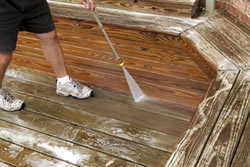 Like others of its kind, DeckBrite is a sodium percarbonate powder that forms hydrogen peroxide (the oxygen-based bleach) and sodium carbonate when mixed with water. The product loosens and lifts the degraded, weathered gray surface along with embedded dirt and mildew, so even low-pressure hose water will rinse it away, Juhn says. "Unlike chlorine bleach products or home-made mixtures, DeckBrite will not soften the wood lignen over time. It dramatically cleans and brightens wood without leaving a whitewashed look, and is harmless to the surrounding plant life and adjacent vinyl or wood siding around a deck." Like others of its kind, DeckBrite is a sodium percarbonate powder that forms hydrogen peroxide (the oxygen-based bleach) and sodium carbonate when mixed with water. The product loosens and lifts the degraded, weathered gray surface along with embedded dirt and mildew, so even low-pressure hose water will rinse it away, Juhn says. "Unlike chlorine bleach products or home-made mixtures, DeckBrite will not soften the wood lignen over time. It dramatically cleans and brightens wood without leaving a whitewashed look, and is harmless to the surrounding plant life and adjacent vinyl or wood siding around a deck."
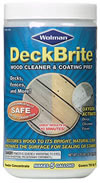 Another type of cleaner, one made with oxalic acid, is a popular choice for cedar and redwood decks. Oxalic acid chemically reacts to leaching tannins and makes them colorless, restoring the wood to its original lighter color. "Oxalic acid takes the gray away," says Jake Clark, president of Armstrong-Clark Co. Another type of cleaner, one made with oxalic acid, is a popular choice for cedar and redwood decks. Oxalic acid chemically reacts to leaching tannins and makes them colorless, restoring the wood to its original lighter color. "Oxalic acid takes the gray away," says Jake Clark, president of Armstrong-Clark Co.
Clark's company makes Armstrong's Wood Cleaner, which contains oxalic acid, soap and water. The industrial-strength wetting soap lets the acid deep into the wood, Clark says. "With everyone else's wood cleaner you have to wait for a length of time for the oxalic acid to work. Ours works as soon as you scrub it into the wood."
Overall, a wash with a cleaner, a light scrubbing, and a pressure wash afterward is the best way to remove gray, he says.
A third kind of bleach, chlorine bleach, is not as effective
or gentle as its cousins, says Juhn. "Using
chlorine bleach and water mixtures, or commercial products
that contain chlorine bleach, can actually soften and
dissolve the wood lignin if used consistently over time. Additionally,
chlorine bleach and water alone will remove mildew but
will not clean away dirt or loosen and lift the weathered gray
surface fibers, and it tends to leave a 'bleached out' look
after rinsing."
 |
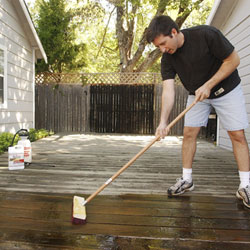 |
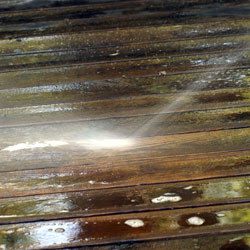 |
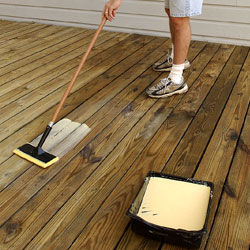 |
Top to Bottom:
1. Spraying on Thompson's Heavy Duty Cleaner.
2. Scrubbing the deck.
3. Hosing down the wood.
4. Applying waterproofer. |
Deck cleaners are playing a more important role in the deck-care market as the stain market changes, says Mike Kozlowski, director of marketing for Thompson's Water Seal brand cleaners. "Many of the newer, longer-lasting waterproofing formulas need to be removed with a stronger cleaner than you would have used in years past. Likewise, more products with color are being used, and a weathered semi-transparent stain requires a different cleaner than a solid stain."
The Thompson's Water Seal line includes a Heavy Duty Deck Cleaner that removes weathered waterproofers and semi-transparent stains. Deck Cleaner & Brightener is an acid-based cleaner that attacks tannin staining on redwood and cedar, while Maximum Strength Deck Stripper removes solid stains, hard-to-remove semi-transparent stains, and tinted and clear waterproofers.
In many cases, a rinse with water will finish the job. However, a brightener should be used to neutralize the wood after using alkaline-based cleaners, Kozlowski says. Kozlowski also recommends neutralizing with a wood brightener after using Maximum Strength Deck Stripper.
Since UV rays make wood turn gray, the way to ward off graying is to block those rays. Oxide pigments in stains and coatings reflect UV rays away from the wood underneath, Clark says. "A transparent oxide pigment is the most expensive and the most effective pigment you can buy. Its oxide pigments are very finely ground, so you can see the wood through the pigment."
What's more, because of the fine grind, a manufacturer can pack a lot of transparent oxide into a transparent or semitransparent stain, reflecting more UV rays with each particle of pigment, he says. "The more pigments in the coating, the more UV protection you get."
Another way to measure the degree to which a pigmented coating will protect against UV graying is opacity, says Juhn. "A general rule to consider is this: The more opaque the color of the coating, the longer the fade resistance and color retention."
Sunlight turns all woods yellowish or brownish, then gray, according to Gary Finseth, vice president of marketing for The Flood Co. "After the initial color change and graying, further changes develop slowly."
FloodPro Supreme Performance premium finish is guaranteed against graying and water damage on exotic hardwoods, cedar, redwood and PTW. "Due to Flood's Acrytrol technology, this waterborne product is able to penetrate the surface like an oil, thus providing ultimate protection," Finseth says.
 |
| The gray color on this new cedar deck was achieved with Thompson's Water Seal Wood Protector plus tinted waterproofer in Sheer Coastal Gray. |
"The basic rule of thumb is the more wood grain you want to see, the more often you will have to recoat your deck over time," Kozlowski says. "Tinted finishes add sheer color without hiding the natural wood grain, and last longer than clear finishes. Semi-transparent stains add more color while still allowing some of the wood's natural wood grain to show through. These provide longer protection than clear and tinted finishes.
"But if you think you may want to change the look of the deck in the future, clears and toners offer you more flexibility than stains, since they are easier to remove."
Finally, what about adding gray? A tinted waterproofer or a penetrating oil finish can add gray color to the wood. Also, a clear, multi-surface waterproofer will protect the wood from water damage while allowing the wood's color to gray naturally, Kozlowski says. "If you like the natural gray color that wood takes on with time, it is still critical that you ensure that the wood is protected from water damage."

|

